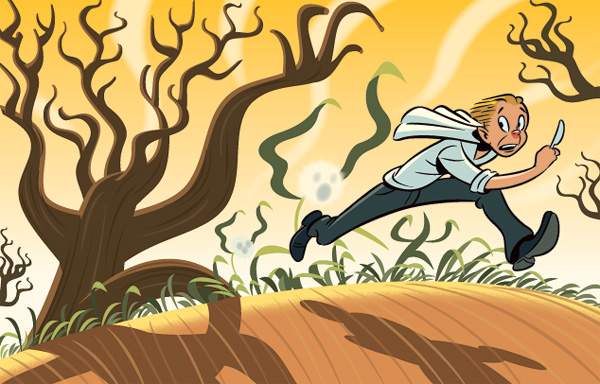One year ago, Hanna Raskin moved from Asheville, North Carolina, to Dallas to become the Dallas Observer’s food critic. She liked our tacos, and the burgers suited her just fine. But during her first trip to the Hill Country, just three weeks after arriving, it became clear that something didn’t agree with her. She chalked it up to all the peaches she had eaten.
But her health continued to deteriorate. She felt like she’d come down with a never-ending case of the flu. After another painful trip to Austin later in the summer, Raskin feared the worst: a salsa allergy.
“It never occurred to me that it was short Texas ragweed,” she says. We spoke over the phone, just as she was packing up to leave Dallas for good.
Her diagnosis came as a surprise because Raskin didn’t have any of the “typical” markers of allergic rhinitis or seasonal allergies, usually characterized by itchy, watery eyes, a runny nose, and excessive honking into a Kleenex. Instead, phlegm was building up inside her intestines, a severe reaction to North Texas’ unique blend of ragweed and grasses. Her doctor suggested staying indoors and following a strict diet, but Raskin rides a bike everywhere and eats for a living.
Finally, after losing 10 pounds (from an already slight frame), she’d had enough. Raskin accepted the post of food critic for the Seattle Weekly, the Observer’s sister paper in the Village Voice Media chain, and beat a hasty retreat for Washington on April 1. She got out just in time. On April 7, according to a Fox Channel 4 story, North Texas registered the fifth-highest pollen counts in the nation.
Raskin’s unplanned exit illustrates how irritating North Texas can be for allergy sufferers. In fact, there are data that suggest the air has gotten worse in recent years. Seven years ago, allergen counts suddenly shot up, and the numbers have yet to return to their previous levels. Then there’s the anecdotal evidence. Dr. Sandeep Gupta, an allergist who serves on the board of the Texas chapter of the Asthma and Allergy Foundation of America (AAFA), says he is giving more allergy shots and seeing more patients than ever before. This year, Dallas moved from No. 52 to No. 35 on the AAFA’s list of top 100 “allergy capitals.” I set out to learn what happened back in 2004 to cause this shift in the air we breathe. Answers, as it turns out, are hard to find. But guesses are all over.
First, if you’re one of the lucky ones, some explanation. The AAFA estimates that 40 million Americans are affected by indoor/outdoor allergies. Pollens, pet dander, trees, grasses, and molds are everywhere, and, technically, they’re harmless. But when a person with allergies is first exposed to his particular allergen, the immune system incorrectly interprets it as an attack. White blood cells produce IgE antibodies, which hang around until the person is exposed again. Then the allergens combine with the antibodies to release the chemical histamine—and the familiar symptoms begin. People sneeze, eyes water, blood vessels open up, and swelling occurs.
That’s the effect. For the cause, we turn to Dr. Jeffrey Adelglass. He runs the only pollen count station in Dallas County certified by the—take a deep breath—American Academy of Asthma, Allergy & Immunology-National Allergy Bureau (AAAAI-NAB). For more than 20 years, Adelglass’ pollen count station has gathered samples from a rooftop near his North Dallas Research Across America facility. He wouldn’t reveal the exact location for “security reasons.” The equipment used to collect the samples, a Rotorod sampler, costs about $2,000. People think it “looks like outer space,” Adelglass says, adding that he’s had samplers destroyed and stolen.
But Adelglass will reveal whose job it is to check the sampler nearly every morning. That task falls to Kelly Walker, director and chief operating officer of Adelglass’ Research Across America, who does it nearly every day. Up on the roof, Walker coats the Rotorod with a silicon gel. The machine rotates every 10 minutes to collect pollen for a full 24 hours. Walker then retrieves the rod, stains it, and, under the supervision of Adelglass, analyzes the slides for molds, weeds, grass, and tree allergens. He reports the levels according to the varying scales set by the AAAAI. The counts are posted online, added to an archive that dates back to 1990.
In 2004, Adelglass’ team noticed a dramatic shift. The number of mold spores suddenly shot up. Mold levels do increase in the warmer months, simply because the spores freeze during the winter. But according to Michael Phillips, who does the number crunching, the 2004 jump was more significant than usual. He says the station went from recording daily levels of 300 to 500 spores per cubic meter to counts of 2,000, 4,000, or higher. They have remained that high ever since.
“Fungus is always there in the environment, from the ground level to 2 miles in the atmosphere,” Phillips says. “So more than likely—I’m not a meteorologist—but more than likely we probably had certain weather patterns coming in at that point that basically shifted the barometric pressure to where it made the spores more easily detectable.” Before you rush out and buy a case of surgical masks, keep in mind that the levels are reported according to the AAAAI’s national scales, and mold is reported differently than grasses, trees, and weeds. A mold level between 1 and 6,499 spores per cubic meter is considered low, which means that Dallas still doesn’t come close to “heavy” (counts of 13,000 to 49,999).
But Phillips says even slight differences can mean a lot to patients, especially severe sufferers who monitor Adelglass’ website every morning. Young Ryu, a business professor at UT Dallas who started seeing Adelglass for allergy symptoms in 1992, uses the pollen counts to decide what medicines to take and whether it’s even worth venturing outside. He says that his allergies are controllable if he limits exposure on the days when the level of trees and grasses are especially high.
So is the weather to blame? I turn to Dr. John Nielsen-Gammon, the state climatologist of Texas and a professor of meteorology at Texas A&M University, for confirmation. During the course of our email exchange, however, it becomes clear that neither temperature nor pressure are the culprits. Nielsen-Gammon didn’t find anything in the average North Texas temperatures to indicate a change in 2004, and he says that barometric pressure during the warm season doesn’t vary more than a few tenths of a percent from year to year.
Gupta has another weather-related theory. He says humidity, especially after a period of drought, could cause an increase in fungal spores because the mold grows and distributes more rapidly in the moist air. According to Nielsen-Gammon’s records, the six years preceding 2004 were all below average precipitation for April through August, but he wouldn’t necessarily call them drought years. In 2004 we had the wettest spring and summer since 1958, though 2008 was even wetter. “Meanwhile,” Nielsen-Gammon writes, “2004 was followed by the drought years of 2005 and 2006, with 2006 being among the 10 driest for April–August.” If humidity were the cause, mold counts should have decreased in the years after 2004.
There is another possible explanation, and this one is inconvenient. “We’re seeing more and more pollution,” Adelglass says. “And pollution is not an allergen, but it makes people feel worse, and that combined with allergies makes people more susceptible to pollen.”
Then there’s the effect pollution has on the allergens themselves. A study published in the May 2010 edition of the peer-review journal Environmental Health Perspectives showed an interesting relationship between carbon dioxide and fungal spores. Alternaria alternata is a common fungus known to trigger allergy symptoms. It also thrives on CO2. Researchers at the University of Maryland grew grass plants for 60 days in controlled chambers with four varying levels of CO2: 19th-century levels, current levels, and two higher levels predicted for 2025 and 2040 by the Intergovernmental Panel on Climate Change. Everything else was held constant. Sure enough, the fungus growing on the grass in the CO2-rich environments reproduced more wantonly, sending off the spores that drive everyone nuts.
Pinning down historical CO2 levels in North Texas is tough. Every summer, the area breaks the Environmental Protection Agency’s allowable limit for ozone, a related greenhouse gas. Nationwide, EPA data show that greenhouse gas emissions have increased by 7.4 percent from 1990 to 2009. C02 from fossil fuel combustion is the largest contributor to U.S. emissions. So it’s a safe bet that C02 levels haven’t dropped in recent years.
Finally, Adelglass believes that there’s yet another contributing element: your new neighbor—and the tree he brought with him from Chicago. “The plants themselves have become more numerous. As the population of Dallas grows, people will put in lawns and trees,” Adelglass says. “And some of them are fond of their trees and plants from where they came from. So they’ll bring with them plants that aren’t indigenous to Dallas.” According to the 2010 Census, Dallas County’s population increased 6.7 percent, to 2,368,139 people, in the last decade.
There’s no cure for allergies, Adelglass says, but monitoring pollen counts can help most people achieve “maximum health and wellness” without having to pull a Hanna Raskin and flee the city entirely. When Ryu, the allergic professor, started treatment, he was suffering a severe sinus infection that left his nasal passages completely blocked and required surgery to correct. Now, after years of medications and immunotherapy, he says that he can breathe.
And if nothing else, North Texas med school students can take this helpful hint: become an allergist. Business is booming.






